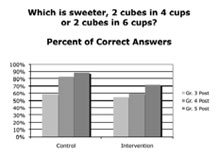Task 1: Same Amount of Sugar, Different Amounts of Water
Task 1 was the easiest of the four since the answer depended solely on the amount of water, given that the amounts of sugar were equal. Children’s difficulty in this task may not stem from lack of proportional reasoning since Task 1 can be solved by focusing on a single variable, without taking into account the specific number of units.
More than half of the third graders gave correct answer to this task. In most cases they justified their correct answers by stating that there was more water in the second container. Performance was consistently higher for the Control group and improved from grades three to five for both groups (see Figure 14).
Children justified wrong answers that the two solutions would be equally sweet by stating that the beakers had the same amount of sugar. Surprisingly, other children, mainly third graders, believed that solution B was sweeter because there was more water to dilute the sugar. These two kinds of justifications support the idea that, at least in younger ages, students’ performance in mixture tasks may be more related to their understanding of how sugar and water interact to produce sweetness when they are mixed than to awkwardness with the mathematical structure.




